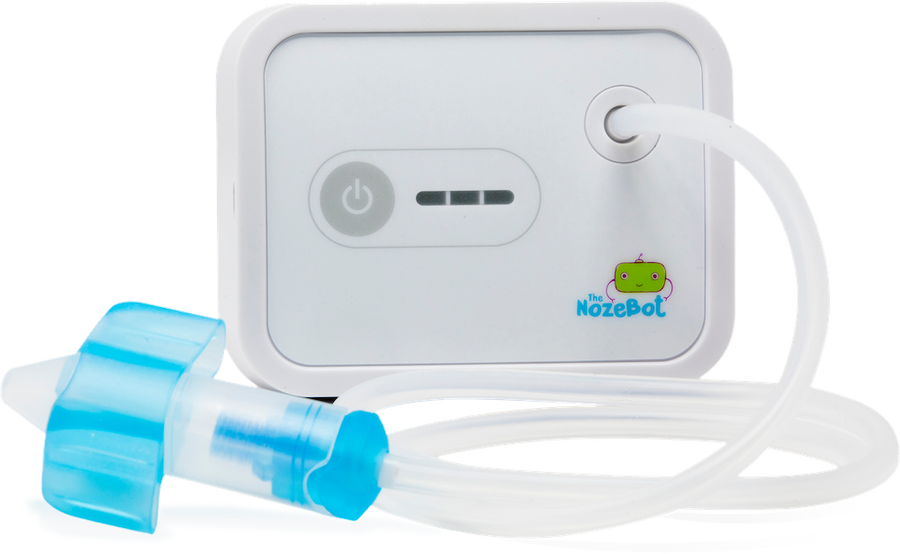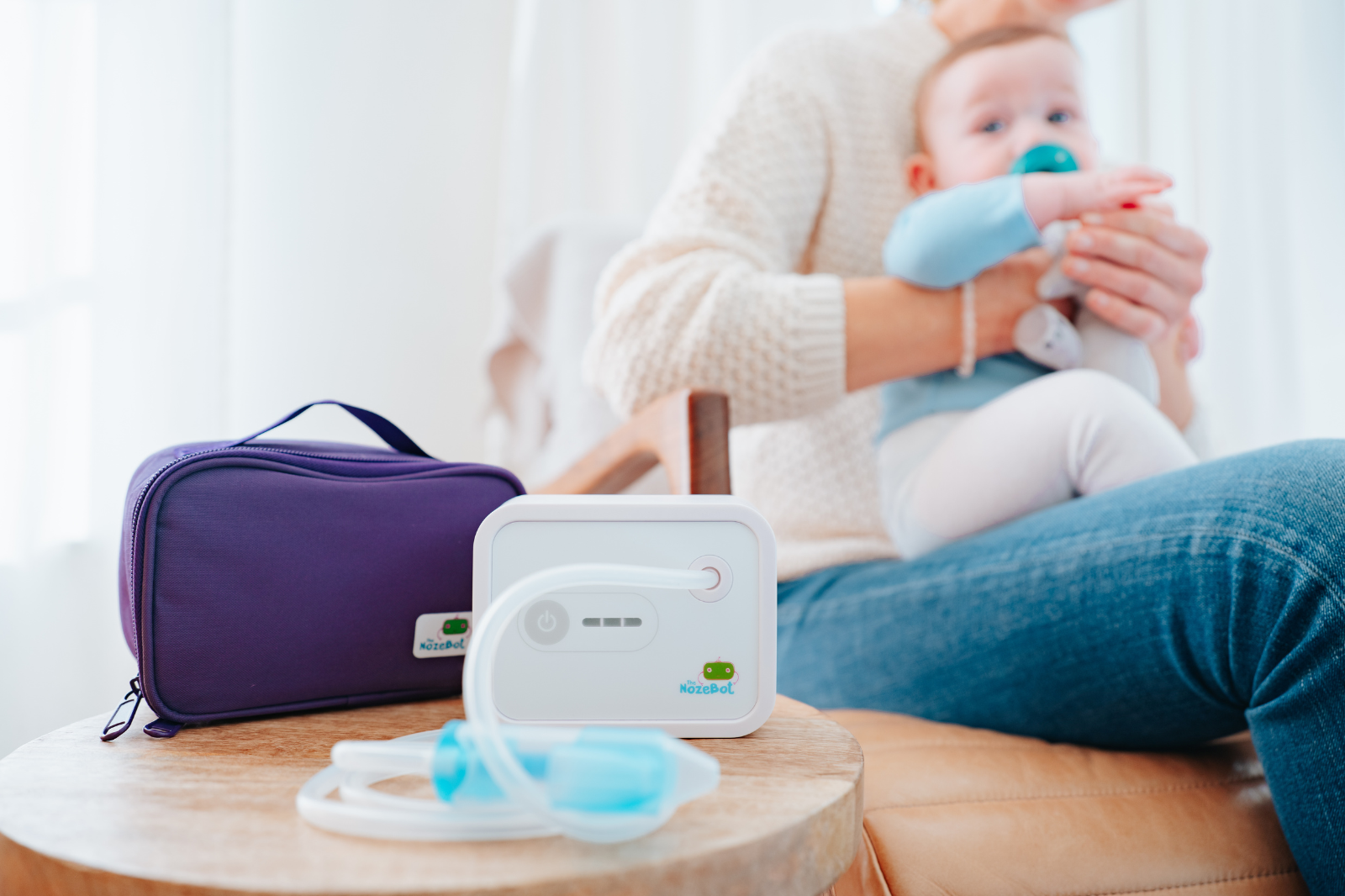Newborn breathing is different from that of older babies, children, and adults, so it can be worrisome for first-time parents who aren’t used to all the noises their little one makes.
In most cases, the stops, starts, grunts, and snorts are nothing to worry about — they’re just your baby’s body adapting to life outside the womb. That said, there are some signs that necessitate a trip to the doctor, so it’s important to be vigilant.
In this article, we discuss the first month of newborn breathing, what it looks like, and the warning signs to look out for.
Table Of Contents
- The Respiratory System And Newborn Breathing
- What Does Normal Newborn Breathing Look Like?
- Signs Of Abnormal Newborn Breathing
- How To Help If Newborn Breathing Becomes Difficult
- When To Visit A Doctor
The Respiratory System And Newborn Breathing

Before delving into the unique aspects of breathing during the first month of life, it’s helpful to examine your little one’s respiratory system in a bit more detail so you understand what’s going on in their tiny little body.
Lungs
Before they were born, your baby’s lungs were filled with a fluid that provided all the oxygen they needed to grow and develop.
During delivery, that fluid was expelled from their lungs and their body switched over to inhaling oxygen and exhaling carbon dioxide.
However, some of that amniotic fluid may still remain in their lungs and affect their initial newborn breathing patterns. This is completely normal and will work itself out as your baby’s lungs grow stronger.
Additionally, when they’re first born, the tiny air sacs (the alveoli) in your baby’s lungs that are responsible for gas exchange (i.e., respiration or breathing) are not as strong as they will eventually be.
Again, this is completely normal but can manifest as newborn breathing that looks and sounds different from the breathing you, as an adult, may be used to.
Airways
Relative to the rest of their body, your newborn’s airways are narrower at birth than they will eventually be.
Because the nasal passages have not widened to their normal diameter yet, it’s much easier for them to become congested with mucus. And, when they do become plugged, your baby may exhibit some type of noisy breathing — especially when they have a cold.
In most cases, this is completely normal and the noisy breathing will go away as your little one’s airways expand to their normal size.
If a stuffy nose is causing your newborn discomfort, affecting their sleep, and making it more difficult to feed, try removing the mucus with the Dr. Noze Best NozeBot.
Muscles
The muscles responsible for breathing — the diaphragm and intercostals — are weaker in newborns, so it’s more of a challenge for them to maintain a consistent breathing pattern.
Similarly, because the muscles haven’t developed to their full strength yet, your newborn may have to breathe more frequently.
Again, this is perfectly normal and any inconsistencies, rapid breathing, and other issues will disappear as your baby gets stronger and their body grows accustomed to life outside the womb.
What Does Normal Newborn Breathing Look Like?

It’s essential for caregivers to recognize normal versus abnormal characteristics of a newborn, which can sometimes feel unclear to first-time parents.
Newborn breathing is particularly important to observe in new babies, and it differs in a few ways from that of children or adults.
Rate
Newborn babies breathe between 40-60 times a minute.
If they are angry, they may temporarily breathe a little faster and readjust to a normal rate when they are calm.
Sleeping babies may breathe 30-40 times a minute.
Anatomy
Newborn babies are belly breathers and rely more on their abdominal muscles to breathe, whereas adults utilize more of the intercostal muscles when breathing.
Because of this, you’ll notice your baby’s abdomen move up and down as they inhale and exhale.
In addition, a newborn breathes primarily through their nose for the first few months of life. Babies start breathing through their mouths sometime between two and six months.
Skin Color
Your baby’s color indicates how well oxygen is circulating throughout their body.
Skin color can vary significantly depending on their genetic disposition, but, generally, babies will have a pinkish hue.
Pattern

Because their lungs, airways, and muscles are still developing, newborns often exhibit irregular breathing patterns such as periodic breathing and apnea of prematurity.
Periodic breathing manifests as brief pauses (less than 10 seconds) between breaths followed by a cluster of rapid breaths. This is a common occurrence in healthy newborns and will typically disappear as their body gets stronger.
Apnea of prematurity is common in premature babies (hence the name) and manifests as pauses in breathing that last longer than 15 seconds. As with periodic breathing, apnea of prematurity usually resolves on its own as your baby matures.
If you notice either of these patterns, keep an eye on your baby’s breathing and talk to a doctor if the symptoms persist or the signs become concerning.
Depth
When you think about an adult taking a deep breath, you may envision their chest and back expanding and their shoulders going up slightly.
This is an indicator of deep breathing because adults (and even older children) use the intercostal muscles around their ribs to expand and contract their lungs.
But, as we mentioned earlier, newborns use their diaphragm — a muscle between the lungs and the belly — to expand and contract their lungs. As a result, their belly will rise and fall with each breath and chest movement will be less noticeable.
Keep in mind that this type of newborn breathing is completely normal, but your little one will eventually switch to breathing with their chest muscles rather than their diaphragm, so you may start to see less belly breathing and more chest breathing.
Sounds
Your baby will make some strange sounds in the first few days and weeks of their life. Grunting, snorting, and wheezing are extremely common during newborn breathing due to the fact that their respiratory system is still developing and mucus may build up inside their airways.
As we’ve mentioned with other aspects of newborn breathing, these sounds are not a cause for alarm.
If, however, the congestion in their nose is disrupting their sleep, feeding, and other regular activities, try clearing the mucus with the Dr. Noze Best NozeBot.
Signs Of Abnormal Newborn Breathing
If you’re concerned about your newborn’s breathing patterns, don’t be afraid to talk to your doctor for more information.
Signs that could indicate that something else is going on — something other than the normal behaviors mentioned throughout this article — include:
- Rapid breathing — Breathing more than 60 times a minute or less than 30 times a minute for more than a brief period of time.
- Involuntary body movements — A tugging motion around the ribs, below the breastbone, or below a baby’s neck. These movements are known as retractions.
- Nasal flaring — When a newborn’s nose widens abnormally in order to take in more oxygen. This may sometimes occur when a baby is feeding or upset, but it should not occur when they’re at rest.
- Skin color — Baby’s skin develops a bluish hue. This is known as cyanosis and may indicate cardiac or respiratory complications.
- Head bobbing — When a baby uses their neck muscles to help provide more oxygen to their body. It usually presents in a rhythmic motion where their head lifts back and forth.
- Grunting — Although newborns can grunt for a variety of reasons (including completely normal bowel movements), the noises may be a concerning symptom especially when accompanied by any of the other abnormal breathing patterns on this list.
If you notice one or more of these symptoms, consult with a doctor, pediatrician, or other healthcare provider right away.
How To Help If Newborn Breathing Becomes Difficult

Suction
One of the best ways to help your newborn if breathing becomes difficult (e.g., they develop a stuffy nose) is to remove the obstruction with gentle suction.
The NozeBot is the perfect tool to help with this and can be far more effective than a nasal bulb.
The process is simple:
- Place your index and middle fingers into the finger grip of the nosepiece
- Allow the tubing to drape over the back of your hand
- Turn on the device
- Choose your level of suction (we recommend always starting on low)
- Gently place the nozzle into your baby’s left nostril
- Switch the nozzle to your baby’s right nostril
Now your little one can breathe easy again!
For more tips and tricks, check out this article from the Dr. Noze Best blog: How to Introduce the NozeBot to Your Baby.
Saline Nasal Drops
Saline nasal drops (or sprays) draw moisture out of your newborn’s nasal tissue in order to reduce swelling. Drops and sprays can also help soften and dissolve the dried mucus causing the problem so it will come out easier (typically with gentle suction).
If you choose to give your baby saline nasal spray or drops, read the entire label first and be sure to follow the instructions.
As a word of caution, the American Academy of Pediatrics (AAP) recommends only using saline sprays and drops in your baby’s nose no more than four times a day.
Warm Bath
Another simple and effective way to help your little one if breathing becomes difficult is a warm bath. Even just spending time in a humid bathroom (without actually getting in the tub) can help reduce the symptoms of nasal congestion.
If you aren’t actually putting your baby in the water (you’re just running it for the steam), you can add an essential oil to help clear clogged nasal passages.
Good choices include:
- Lemon
- Eucalyptus
- Lavender
- Tea tree
- Rosemary
- Peppermint
- Clary sage
Whichever scent you choose, use only one or two drops (to a full bathtub of water) at a time so you don’t overwhelm your little one’s delicate system.
Cool Mist Humidifier
If newborn breathing issues are a problem at night, you can try running a cool mist humidifier to raise the moisture slightly and help prevent the mucus from becoming so thick that it plugs their nose.
As with steam, you can add an essential oil to the cool mist humidifier if you want. The scent of these oils can help clear clogged nasal passages.
One or two drops of clary sage, peppermint, eucalyptus, lemon, tea tree, or lavender is all it takes, so don’t overdo it with too much essential oil.
Elevation
If breathing issues persist when it’s time for bed, try elevating their mattress slightly. Doing so can help improve the flow of mucus and make it easier for your little one’s body to clear the obstruction.
Keep in mind that it doesn’t take a lot of elevation to make this happen — a rolled-up towel or blanket under one end of the mattress is plenty.
Be sure to place your baby’s head on the high end of the mattress when it comes time to sleep.
When To Visit A Doctor

If you notice any of the signs of abnormal breathing mentioned earlier, take your newborn to the doctor right away.
Similarly, if your baby develops a fever, refuses to feed, or is lethargic during normal waking hours, consult with a healthcare professional for further guidance.
Even if you don’t see any of the signs or symptoms but something just feels off, don’t hesitate to talk to your doctor. It may be nothing, but it’s always OK to ask questions!
Breathing Easy!
Most of the unique signs of newborn breathing are completely normal and are nothing to worry about. But, if you notice your little one’s breathing patterns and behaviors change, they may be developing respiratory distress.
Recognizing these abnormal breathing patterns will allow you to care for your baby more effectively in times of illness.
If you are concerned about any aspect of your baby’s breathing, notify your baby’s primary care doctor and always call 911 for emergencies.
If you enjoyed this article, you’ll love these, too:
- Postpartum Series: Anxiety, Self Love and Giving Ourselves Grace
- Common Mistakes Parents Make When Using a Nasal Aspirator
- What You Need to Know About RSV
- Navigating Back to School Bugs
- The Importance of Tummy Time on Your Newborn's Breathing
After all, newborns can't breathe out of their mouth for up to one year!


